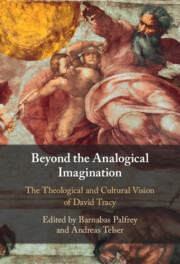Book contents
- Beyond the Analogical Imagination
- Reviews
- Beyond the Analogical Imagination
- Copyright page
- Epigraph
- Contents
- Contributors
- Acknowledgements
- Introduction
- Part I Theology and Culture
- Chapter 1 David Tracy’s Theology-in-Culture
- Chapter 2 Analogical Imagination and Ana-theological Believing
- Chapter 3 Closed Totality, Collage, and the Fragmentary Between
- Part II Public and Beyond
- Part III Church and World
- Part IV From David Tracy
- Part V Post-Script
- Bibliography
- Index
Chapter 1 - David Tracy’s Theology-in-Culture
from Part I - Theology and Culture
Published online by Cambridge University Press: 28 September 2023
- Beyond the Analogical Imagination
- Reviews
- Beyond the Analogical Imagination
- Copyright page
- Epigraph
- Contents
- Contributors
- Acknowledgements
- Introduction
- Part I Theology and Culture
- Chapter 1 David Tracy’s Theology-in-Culture
- Chapter 2 Analogical Imagination and Ana-theological Believing
- Chapter 3 Closed Totality, Collage, and the Fragmentary Between
- Part II Public and Beyond
- Part III Church and World
- Part IV From David Tracy
- Part V Post-Script
- Bibliography
- Index
Summary
David Tracy’s theological formation and work stretch across more than five decades of his emergent ‘theology-in-culture’. Diachronically, this essay highlights: (1) the influence of Bernard Lonergan; (2) how Blessed Rage for Order (1975) articulated a ‘critical not dogmatic’ theology turned towards a ‘twofold crisis’ of Christian meaning in post-Christian times and modern meaning in post-modern times; (3) how The Analogical Imagination (1981) clarified this ‘mutually critical’ reading-together of historical tradition and contemporary situation, opening it to radical problematisings of interpretation and culture; and (4) how this then has led Tracy to identify cultural and religious classics as ‘fragments’ and ‘frag-events’. Taken as a whole, Tracy’s theology-in-culture follows ‘an analogical paradigm’ that regards the human creature as having a transcendentally driven grace-informed nature, in spite of tragedy and sin. Hence, art and conversation remain theological hopes for Tracy, and when the noble endeavours of modernity yield to post-modern fragmentation even this remains hopeful for Tracy, because humans inhabit an invisible infinity which exceeds the visible world.
Keywords
- Type
- Chapter
- Information
- Beyond the Analogical ImaginationThe Theological and Cultural Vision of David Tracy, pp. 21 - 40Publisher: Cambridge University PressPrint publication year: 2023

